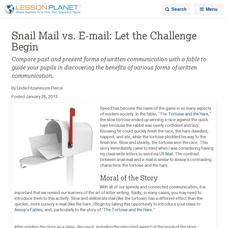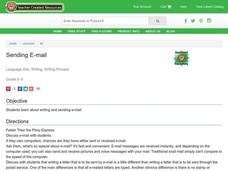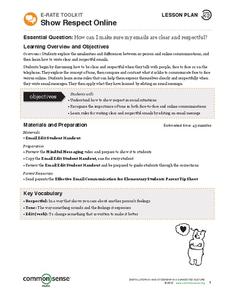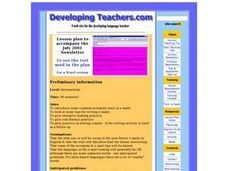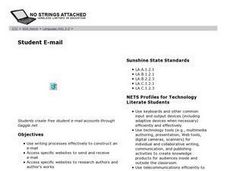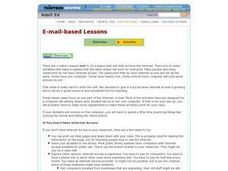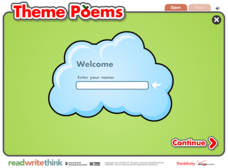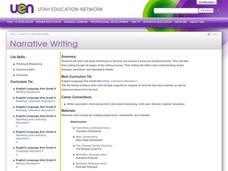Curated OER
There's a Monster in My E-Mail!
Don't be scared of these monsters! Middle schoolers make new friends as they practice their drawing, writing, and computer skills. They participate in a collaborative e-mail project in which they draw and describe pictures of monsters...
Curated OER
Snail Mail vs. E-mail: Let the Challenge Begin
Compare past and present forms of written communication with a fable to guide your pupils in discovering the benefits of various forms of written communication.
Curated OER
Sending E-mail
Middle schoolers learn about writing and sending e-mail. They discuss the differences between the ways messages may travel. Then, they learn and compare the writing process between e-mail and regular mail.
University of North Carolina
Effective Email Communication
Despite its speed and convenience, an e-mail may not always be the best form of communication. As part of a series on specific writing assignments, a handout shares information on effective e-mail communication. In addition to outlining...
Common Sense Media
Show Respect Online
Through discussion and a variety of worksheet types, pupils learn to review their e-mails for grammar, appropriateness, and respect before sending.
British Council
Unit 9: Email Etiquette
Manners matter! The ninth and final lesson in a series of career education and skills activities focuses on hitting a happy medium in business correspondence. Scholars master five simple rules for creating e-mails that are friendly,...
Open Oregon Educational Resources
Technical Writing
Hate having to look in multiple sources to find information?Technical Writing contains all information in one book! The book covers everything from defining technical writing, giving examples of technical writing, and tips for creating...
Curated OER
E-Mail Interviews
Students dictate an e-mail interview. In this interview and early e-mail instructional activity, students brainstorm questions for a person they would like to interview. Then, they dictate their questions to the teacher for her/him to...
Purdue University
Email Etiquette for Students
What's the best way to discuss a problem or concern with a professor? Using a helpful PowerPoint, scholars learn how to use e-mail to communicate effectively with their instructors. They discover good and bad e-mail topics, appropriate...
British Council
Unit 7: Organising Your Writing
Get energized by being organized! Budding business scholars construct professional letters in the seventh of nine career education and skills lessons. The resource covers proper greetings, writing requests, and explaining reasons for...
Curated OER
BBC Learning English, Writing (E-mail)
In this ESL writing worksheet, students compare their own culture to that of England, then identify phrases used for comparing and contrasting. Students write an e-mail message describing some of these differences using the comparison...
Curated OER
Acronyms Used in E-mails
Learners examine some common acronyms used in e-mail and at how to write e-mail.
Curated OER
Student E-mail
Guide your pupils through the process of creating a free e-mail account on Gaggle.net. Once the accounts are established, class members contact authors and practice letter writing techniques. This lesson includes resource links and is...
Curated OER
Visible Speech: A Short Course in the Fundamentals of Writing
Introduce your class to various forms of writing. As the title states, this is a short PowerPoint, giving brief, but accurate descriptions of what each type of writing is used for. Pictorial representations are also helpful.
Curated OER
E-mail Abbreviations
Young scholars identify an abbreviation or acronym for communication purposes. Students write various messages using each correctly. Young scholars make a list of the most common abbreviation and acronyms used currently.
Curated OER
E-mail-based Lessons
Students practice using computers. They use the Internet to practice surfing the web and finding information. They also practice writing emails and journal entries.
Scholastic
Writing Letters of Gratitude
A lesson begins with a discussion on gratitude—what does it mean, and for who are learners thankful? Scholars share their thoughts and feelings then choose a community worker to which they wish to share their gratitude. Writers compose a...
Common Sense Media
Sending Email
Youngsters are introduced to the idea of communicating through e-mail, and gain important foundational knowledge for how to interact safely online.
Benjamin Franklin Tercentenary
From Ben’s Pen to Our Lives
What would Ben do? Jumping off from the pseudonymous letters Ben Franklin fooled his older brother into publishing when he was still a teenager, young literary lovers dive into acting, writing, and addressing a local issue with wit and...
ReadWriteThink
Theme Poems
Continue celebrating Poetry Month with an interactive whose focus is writing shape, or theme, poems. Young poets choose from nature, school, shapes, sports, and celebration themes. Then, they brainstorm words that have to do with the...
Curated OER
Narrative Writing
Binoculars are used as a metaphor for good descriptive writing. Class members first view a small picture and then an enlarged view of the same image in which the details come into focus. Next, learners examine a paragraph lacking sensory...
Curated OER
Technology-Based Lesson on Letter Writing
Second graders discuss the non-verbal ways to communicate. They word process letters to their teachers expressing five of their favorite things to do after school. They set up e-mail and send their letters to an e-pal.
Kent State University
How Does that Work?
Sixth and seventh graders explore algebra word problems. They work with a partner to solve word problems distributed by e-mail. Learners simplify mathematical expressions following a "think aloud" algebra strategy modeled by the teacher....
Curated OER
Writing a Letter to a Friend
First graders practice their letter writing skills by writing to a fictional character. For this formal writing lesson, 1st graders read the books The Jolly Postman and Frog and Toad are Friends to examine the different parts of a...



